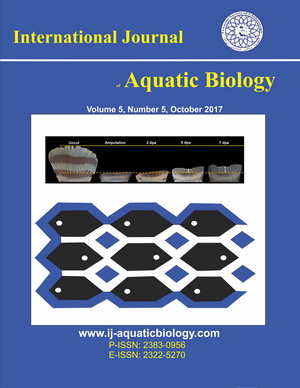Teratogenicity and hepatotoxicity of rifampicin exposure in Zebrafish
Downloads
Antibiotics belong to a large group of pharmaceutical substances that tend to kill or prevent the growth of bacteria like rifampicin and other antibiotics. The overuse of rifampicin has resulted in the accumulation in the natural environment and has potential health hazard that involves carcinogenicity, mutagenicity, reproductive toxicity, and neurotoxicity. This study focuses on the toxic effects of rifampicin on zebrafish embryos and follows OECD 236 guidelines. The embryos are treated with 1.25, 2.5, 5, and 10 mg/L of rifampicin for a range of 4-96 hours post-fertilization. Exposed zebrafish embryos showed a variety of deformities in somites, spines, tails, hearts, and yolk sacs. Heart rate was decreasing with increasing centration of rifampicin. For adults, we exposed 5, 10, and 20 mg/L of rifampicin. The hepatotoxicity was assessed by expression of SOD, GH1, and TNF-? gene and observed a spike in the expressed at a low dose (5 mg/L) by 2.13-fold, 15.6-fold, and 3.53-fold, respectively. MDA levels were 0.32 and 0.39 nM at 10 and 20 mg/L of rifampicin, respectively. Therefore, zebrafish provide new insights into the toxicological effects of pharmaceuticals, and we found teratogenicity and rifampicin-induced hepatotoxicity in adult zebrafish.
Downloads
Jijie R., Mihalache G., Balmus I.M., Strungaru S.S., Baltag E.S., Ciobica A., Nicoara M., Faggio C. (2021). Zebrafish as a screening model to study the single and joint effects of antibiotics. Pharmaceuticals, 14(6): 578.
Carvalho I.T., Santos L. (2016). Antibiotics in the aquatic environments: a review of the European scenario. Environment International, 94: 736-757.
Abbasi A.R., Rizvandi M. (2018). Influence of the ultrasound-assisted synthesis of Cu–BTC metal–organic frameworks nanoparticles on uptake and release properties of rifampicin. Ultrasonics Sonochemistry, 40: 465-471.
Cai W., Weng X., Chen Z. (2019. Highly efficient removal of antibiotic rifampicin from aqueous solution using green synthesis of recyclable nano-Fe3O4. Environmental Pollution, 247: 839-846.
Bailey J., Oliveri A., Edward D. Levin. (2013). Zebrafish model systems for developmental neurobehavioral toxicology. Birth Defects Research Part C: Embryo Today: Reviews, 99(1): 14-23.
Vasamsetti B.M.K., Chon K., Kim J., Oh J.A., Yoon C.Y., Park H.H. (2022). Developmental Toxic Effects of Thiram on Developing Zebrafish (Danio rerio) Embryos. Toxics, 10(7): 369.
Gut P., Reischauer S., Stainier D.Y., Arnaout R. (2017). Little fish, big data: zebrafish as a model for cardiovascular and metabolic disease. Physiological Reviews, 97(3): 889-938.
Wiegand J., Avila-Barnard S., Nemarugommula C., Lyons D., Zhang S., Stapleton H.M., Volz D.C. (2023). Triphenyl phosphate-induced pericardial edema in zebrafish embryos is dependent on the ionic strength of exposure media. Environment international, 172: 107757.
Sant K.E., Timme-Laragy A.R. (2018). Zebrafish as a model for toxicological perturbation of yolk and nutrition in the early embryo. Current Environmental Health Reports, 5: 125-133.
Hill A.J., Teraoka H., Heideman W., Peterson R.E. (2005). Zebrafish as a model vertebrate for investigating chemical toxicity. Toxicological Sciences, 86(1): 6-19.
Vasamsetti B.M.K., Chon K., Kim J., Oh J.A., Chang-Young Y., Hong-Hyun P. (2022). Developmental toxic effects of thiram on developing zebrafish (Danio rerio) Embryos. Toxics, 10(7): 369.
Chen Q-L., Sun Y.L., Liu Z.H., Li Y.W. (2017). Sex-dependent effects of subacute mercuric chloride exposure on histology, antioxidant status and immune-related gene expression in the liver of adult zebrafish (Danio rerio). Chemosphere, 188: 1-9.
Yang X., Xue W., Daili G., Yun Z., Xiqiang C., Qing X., Meng J. (2021). Developmental toxicity caused by sanguinarine in zebrafish embryos via regulating oxidative stress, apoptosis and wnt pathways. Toxicology Letters, 350: 71-80.
Sato Y., Dong W., Nakamura T., Mizoguchi N., Nawaji T., Nishikawa M., Onaga T., Ikushiro S., Kobayashi M., Teraoka H. (2023). Transgenic zebrafish expressing rat cytochrome P450 2E1 (CYP2E1): Augmentation of acetaminophen-induced toxicity in the liver and retina. International Journal of Molecular Sciences, 24(4): 4013.
Xu B.Y., Tang X.D., Chen J., Wu H.B., Chen W.S., Chen L. (2020). Rifampicin induces clathrin-dependent endocytosis and ubiquitin-proteasome degradation of MRP2 via oxidative stress-activated PKC-ERK/JNK/ p38 and PI3K signaling pathways in HepG2 cells. Acta Pharmacologica Sinica, 41(1): 56-64.
Rashidian G., Boldaji J.T., Rainis S., Proki? M.D., Faggio C. (2021). Oregano (Origanum vulgare) Extract enhances zebrafish (Danio rerio) growth performance, serum and mucus innate immune responses and resistance against Aeromonas hydrophila challenge. Animals (Basel), 11(2): 299.
Huang J.H., Zhang C., Zhang D.G., Li L., Chen X., Xu D.X. (2016). Rifampicin-induced hepatic lipid accumulation: Association with up-regulation of peroxisome proliferator-activated receptor ? in mouse liver. PLoS One, 11(11): e0165787.
Alengebawy A., Abdelkhalek S.T., Qureshi S.R., Wang M.Q. (2021). Heavy metals and pesticides toxicity in agricultural soil and plants: Ecological risks and human health implications. Toxics, 9(3):42.
Stokes J.M., Lopatkin A.J., Lobritz M.A., Collins J.J. (2019). Bacterial Metabolism and Antibiotic Efficacy. Cell Metabolism, 30(2): 251-259.
Cai W., Weng X., Chen Z. (2019). Highly efficient removal of antibiotic rifampicin from aqueous solution using green synthesis of recyclable nano-Fe3O4. Environmental Pollution, 247: 839-846.
Kulik K., Lenart-Boro? A., Wyrzykowska K. (2023). Impact of antibiotic pollution on the bacterial population within surface water with special focus on mountain Rivers. Water, 15(5):975.
Peek J., Xu J., Wang H., Suryavanshi S., Zimmerman M, Russo R, Park S., Perlin D.S., Brady S.F. (2020). A Semisynthetic kanglemycin shows in vivo efficacy against high-burden rifampicin resistant pathogens. ACS Infectious Diseases, 6(9): 2431-2440.
Khan A.U., Khan A.N., Waris A., Ilyas M., Zamel D. (2022). Phytoremediation of pollutants from wastewater: A concise review. Open Life Sciences, 17(1): 488-496.
Chahardehi A.M., Arsad H., Lim V. (2020). Zebrafish as a successful animal model for screening toxicity of medicinal plants. Plants (Basel), 9(10): 1345.
Bauer B., Mally A., Liedtke D. (2021). Zebrafish Embryos and Larvae as Alternative Animal Models for Toxicity Testing. International Journal of Molecular Sciences, 22(24): 13417.
Zakaria Z.Z., Benslimane F.M., Nasrallah G.K., Shurbaji S., Younes N.N., Mraiche F., Da'as S.I., Yalcin H.C. (2018). Using zebrafish for investigating the molecular mechanisms of drug-induced cardiotoxicity. BioMed Research International, 1642684.
Basal O.A., Zahran R.F., Saad E.A. (2023). Rifampicin efficacy against doxorubicin-induced cardiotoxicity in mice. Egyptian Heart Journal, 75(1): 73.
Zhang J., Ren Z., Chen M. (2023). Immunotoxicity and Transcriptome Analyses of Zebrafish (Danio rerio) Embryos Exposed to 6:2 FTSA. Toxics, 11(5): 459.
Dhindsa R.S., Plumb-Dhindsa P.A., Thorpe T.A. (1981). Leaf senescence: correlated with increased levels of membrane permeability and lipid peroxidation, and decreased levels of superoxide dismutase and catalase. Journal of Experimental Botany, 32(1): 93-101.
Copyright (c) 2024 International Journal of Aquatic Biology

This work is licensed under a Creative Commons Attribution 4.0 International License.








